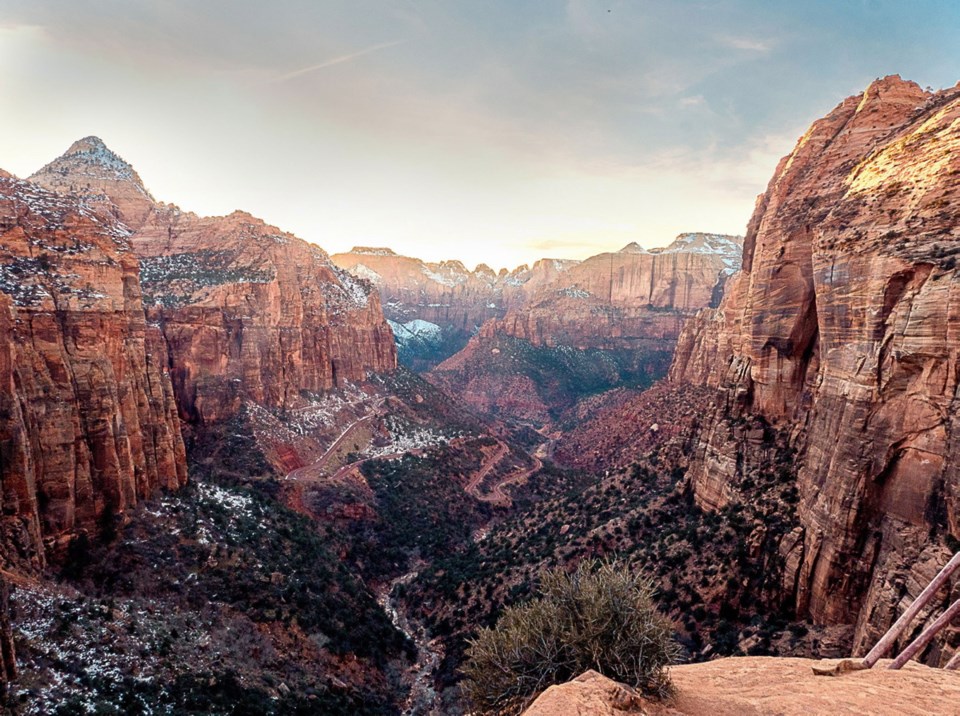ŌĆśThis is a great time to come.ŌĆØ One hears that a lot from the locals when visiting Zion National Park in winter. Fewer people, easy parking, available hotel rooms, much less crowded trails, beautiful snow-covered vistas, no oppressive heat. WhatŌĆÖs not to like?
There are these slight negatives: the relative cold, some shuttered-for-the-winter restaurants or ones that close by 8 p.m. in nearby Springdale, the closure of some trails due to falling ice and rocks, and the possibility of plunging to your death off ice-covered roads and hiking trails.
Life is a balance, right?
According to the National Park Service, more than 200,000 people visited Zion during January and February of 2016. Compare that with the more than 1.1╠²million visitors in June and July last year. In winter, itŌĆÖs a lot easier to get around.
A big part of getting around is driving your own car on the Zion Canyon Scenic Drive.
Turn up the heater, open up the windows and sunroof and enjoy the majestic views. But this is a wintertime experience only. From mid-March to mid-November, that part of Zion is closed to private vehicles, except those of guests at the Zion Lodge. During spring, summer and fall, there is a shuttle service to alleviate ŌĆ£traffic and parking problems, protect vegetation and restore tranquillity to Zion Canyon,ŌĆØ according to the Park Service.
Once you park the car, the trails beckon.
A word of caution: Some trails might be closed because of hazardous conditions.
ItŌĆÖs a good idea to check in at the ranger station on your way in to see which trails are restricted.
During my visit, the lower Emerald Pools Trail and the upper part of The Narrows were closed because of falling rocks, snow and ice.
Speaking of snow and ice, there was a fair amount of it ... especially at higher elevations such as the Kolob Canyons. Crampons are a must in winter if you want to hike the Taylor Creek and La Verkin Creek trails. The snow and ice can make an ŌĆ£easyŌĆØ hike (ranger speak for ŌĆ£thereŌĆÖs only a 25 percent chance of falling to your deathŌĆØ) seem more like an X-Games competition.
There are warning signs at the trailheads for the more challenging routes. They encourage or warn or recommend that hikers take precautions. For example, the trailhead signs at Angels Landing (a harrowing hike known to turn grown men into terrified puddles of pudding) reads: ŌĆ£The route is not recommended during high winds, storms, or if snow or ice is present.ŌĆØ That is ranger-speak for ŌĆ£DONŌĆÖT DO IT!ŌĆØ
Some signs report there have been deaths on those trails. IŌĆÖm guessing more than a few. Actual number: 30 since the parkŌĆÖs inception, according to the Park Service. And donŌĆÖt assume that just because a trail is marked ŌĆ£easy/moderate,ŌĆØ itŌĆÖs time to turn your brain off. Fun fact: More people have died on the Emerald Pools trails than Angels Landing.
Another thing to remember: wear layers. At the upper reaches of some trails, itŌĆÖs cold. Thermals, sweatshirts and light jackets will keep you warm up there with the condors, but you will be stripping outerwear faster than Magic Mike on the way down as the day warms.
And if you donŌĆÖt feel the need to up your life insurance policy, there are wonderful strolls to the lower Emerald Pool, Weeping Rock and along the Virgin River at the end of Zion Canyon Scenic Drive at The Temple of Sinawava. Or drive up the switchback and through the tunnel on the Zion-Mount Carmel Highway to the eastern gate of the park.
Another must-drive is to exit the park at Springdale and take a 40-minute trip on Highway 9 and Interstate 15 to the Kolob Canyons at the northern part of Zion. In the park, the roads are freshly plowed and easily passable. ItŌĆÖs quiet and peaceful and a little lonely. During my visit, I was the only person there besides the rangers in the station below.
So if you like winter, but not the crowds at some resorts, try Zion for its amazing vistas, drives and hikes. Just plan on eating dinner early.
╠²
ZION NATIONAL PARK
Zion Canyon Visitor Center open from 8 a.m. to 5 p.m. daily except Christmas Day
Kolob Canyons Visitor Center open from 8 a.m. to 4:30 p.m. daily except Christmas Day
Fees: $30 US per vehicle, $25 for motorcycle, $15 per individual for pedestrians, bicycle or organized group. Entrance fees valid for seven days.
Lodging: To stay in the park, there is the Zion Lodge. See zionlodge.com. In Springdale, there many hotels and inns.
Camping: reservations or first-come, first-served information, see recreation.gov.
Food: During winter months, some restaurants are closed or end service by 8 or 9 p.m. Check with the front desk of your hotel for a list of the open restaurants and their hours.
Hiking equipment: Dry suits are recommended for The Narrows. There are a few gear-rental places in Springdale: Zion Adventure Company, Zion Guru, Zion Outfitters and Zion Rock and Mountain Guides. Be sure to check ahead to see if reservations for hiking equipment is required


